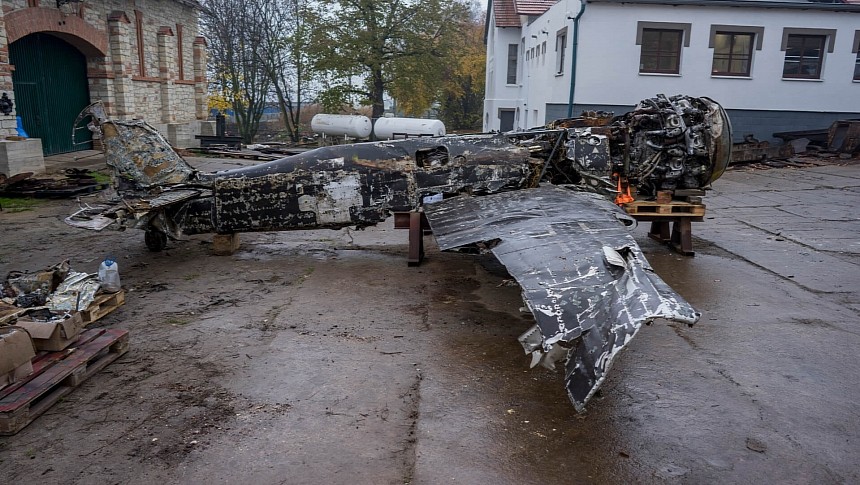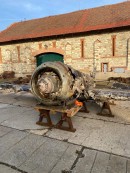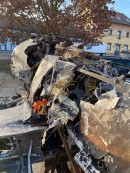In its day, pilots used to call the Focke-Wulf Fw-190 the Würger (Butcher Bird) because it was so adept at shooting down Allied aircraft. But when this 1944 example was pulled from the woods in Northwest Russia, the only thing it was shooting down was our hearts, thanks to its sorry state. But if you think a wreck of this magnitude has no chance of looking stunning again, you must not be familiar with what aviation restoration mechanics are capable of with enough time and money.
This particular late-model Fw-190F-8, complete with modified injectors on the engine compressor on its BMW 801D-2 radial engine, was one of 16 such fighter bombers stationed at a Luftwaffe base near Alakurtti, Finland, and played a role in the German-Finnish defense of Finland's home territory against the advancing Soviet Army and Air Force as a part of what's known as the Continuation War. So the legend goes, Luftwaffe pilot Alfred Kruppa was at the stick of this very Fw-190, flying close to the border between Finland and modern-day Russia, when he was intercepted by Soviet pilots flying British Hawker Hurricanes they'd acquired via Lend-Lease.
From what historians can gather, Kruppa's plane was hit by a barrage from the Hurricane's quad 20 mm Hispano Mk II cannons and was forced to make an emergency bail-out and perished on impact with the nearby Vuoksi River. The Fw-190 he was flying was totaled on impact, but the aircraft's superstructure remained intact as it sat on the river floor for the next 75 years. The plane sat undisturbed, collecting a thick layer of dust and woodland biomass across its wings, cockpit, and fuselage until the summer of 2019 when it was spotted by locals and extracted from its crypt in the hope of a full and total restoration.
It doesn't look like there's much left of anything to restore on this crusty mass of metal and wires. But veteran readers of autoevolution might recall the Curtiss P-40 Warhawk at the Glenn H. Curtiss Museum in New York State that was restored from the wrecks of two identical planes that'd collided mid-air almost eight decades ago. If that pile of barely recognizable scrap can be re-arranged into something even just resembling the warbirds they came from, can you imagine what's possible with an ostensibly intact and complete airframe like this one?
It won't be easy, and restoration projects of this variety routinely take decades to complete before they're ready for museum display. It's not like spare parts for these machines haven't been made since 1945 or anything. Oh, wait, that's exactly the case. Maybe it's best that the people involved take their sweet time, lest a wayward nut or bolt comes loose that brings the project all the way back to square one rears its ugly head.
From what historians can gather, Kruppa's plane was hit by a barrage from the Hurricane's quad 20 mm Hispano Mk II cannons and was forced to make an emergency bail-out and perished on impact with the nearby Vuoksi River. The Fw-190 he was flying was totaled on impact, but the aircraft's superstructure remained intact as it sat on the river floor for the next 75 years. The plane sat undisturbed, collecting a thick layer of dust and woodland biomass across its wings, cockpit, and fuselage until the summer of 2019 when it was spotted by locals and extracted from its crypt in the hope of a full and total restoration.
It doesn't look like there's much left of anything to restore on this crusty mass of metal and wires. But veteran readers of autoevolution might recall the Curtiss P-40 Warhawk at the Glenn H. Curtiss Museum in New York State that was restored from the wrecks of two identical planes that'd collided mid-air almost eight decades ago. If that pile of barely recognizable scrap can be re-arranged into something even just resembling the warbirds they came from, can you imagine what's possible with an ostensibly intact and complete airframe like this one?
It won't be easy, and restoration projects of this variety routinely take decades to complete before they're ready for museum display. It's not like spare parts for these machines haven't been made since 1945 or anything. Oh, wait, that's exactly the case. Maybe it's best that the people involved take their sweet time, lest a wayward nut or bolt comes loose that brings the project all the way back to square one rears its ugly head.














